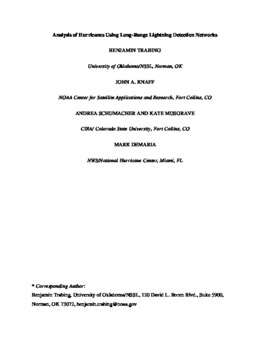| dc.contributor.author | Trabing, Benjamin | |
| dc.contributor.author | Knaff, John A. | |
| dc.contributor.author | Schumacher, Andrea | |
| dc.contributor.author | Musgrave, Kate | |
| dc.contributor.author | Demaria, Mark | |
| dc.date.accessioned | 2016-05-13T20:52:41Z | |
| dc.date.accessioned | 2021-04-14T14:56:34Z | |
| dc.date.available | 2016-05-13T20:52:41Z | |
| dc.date.available | 2021-04-14T14:56:34Z | |
| dc.date.issued | 2016 | |
| dc.identifier.uri | https://hdl.handle.net/11244.46/70 | |
| dc.description.abstract | The new GOES-R satellite will be equipped with the Geostationary Lightning Mapper (GLM) that will provide unprecedented total lightning data with the potential to improve hurricane intensity forecasts. Past studies have provided conflicting interpretations of the role that lightning plays in forecasting tropical cyclone (TC) intensity changes. With the goal of improving the usefulness of total lightning, detailed case studies were conducted of five TCs that underwent rapid intensification (RI) within the domains of two unique ground-based long-range lightning detection networks, the World Wide Lightning Location Network (WWLLN) and Earth Networks Total Lightning Network (ENTLN). This analysis will provide greater details of the distribution of lightning within predefined storm features to highlight specific phenomena that large statistical studies cannot resolve. | en_US |
| dc.description.abstract | Both WWLLN and ENTLN datasets showed similar spatial and temporal patterns in lightning that validates the independent use of either network for analysis. For the cases examined, a maxima in eyewall lightning was located downshear and in the front-right quadrants relative to storm motion. Results show that RI follows a burst of lightning in the eyewall when coinciding with a period of little environmental vertical shear. Eyewall lightning would cycle with greater frequency during intensification compared to weakening. Bursts of lightning were observed in the eyewall just prior to eye formation in both the infrared and microwave imagery. Eyewall lightning bursts in low shear environments could be used to indicate intensification and improve forecasts. | en_US |
| dc.description.abstract | University Libraries Undergraduate Research Award | en_US |
| dc.language.iso | en_US | en_US |
| dc.rights | Attribution-NonCommercial-ShareAlike 3.0 United States | * |
| dc.rights.uri | https://creativecommons.org/licenses/by-nc-sa/3.0/us/ | * |
| dc.subject | Geostationary Lightning Mapper | en_US |
| dc.subject | hurricane intensity forecasts | en_US |
| dc.subject | World Wide Lightning Location Network | en_US |
| dc.subject | Earth Networks Total Lightning Network | en_US |
| dc.subject | University Libraries Undergraduate Research Award | en_US |
| dc.title | Analysis of Hurricanes Using Long-Range Lightning Detection Networks | en_US |
| dc.type | Other | en_US |
| dc.description.undergraduate | undergraduate | |

